2012 Yamaha FX Cruiser HO Review
New ride, clever new features...same powerful performance
Something old, something new, something borrowed, something…
Well, it’s silver, not exactly Yamaha blue.
The mantra, however, pretty much nails the 2012 Yamaha FX Cruiser HO. In many ways it’s the old familiar FX, but in many ways it’s got enough new features to make you quickly forget that former model. And though borrowed some features may be (the engine is Yamaha’s familiar, proven 1.8-liter), the end result will have you feeling anything but blue.
Let’s meet Yamaha’s lowest-priced FX Cruiser…and discover why some key changes have made it worthy of your renewed interest.
Refresh
The obvious change to the Cruiser HO is one that is seen throughout the FX line for 2012 — a bold, aggressive look accomplished by adding new style elements to the existing FX deck. Sure, we overuse the word, but it’s edgier than the last installment and gives the craft a welcome refresh. Most of those elements are actually molded components seamlessly bolted onto the deck, a choice that provides some opportunity as well. A great example is seen aft below the seat. The extended lines incorporate a clever trunk space that can be used to stow wet towlines or the like. The fact that the door is actually notched to allow a towrope to stay attached shows nice attention to detail.
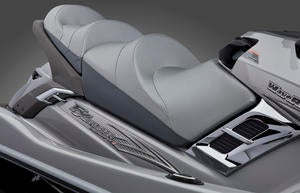 A tiered cruising saddle offers passengers a clear view over the driver.
A tiered cruising saddle offers passengers a clear view over the driver.Complimenting the styling is a welcome stretch in overall length, about 7.5 inches in total. Some of that space (about 3”) is used in the saddle to provide more space for passengers; the remainder goes to the aft boarding area.
Both of the aforementioned features get tweaks to improve the experience. That cruiser saddle is now tiered movie-theater style, with each subsequent seat significantly raised above the one in front. Each seat has its own bolster as well, meaning you won’t be crammed together but rather each passenger ensured his own space. The tiered approach lets each passenger have a little boost in height (a 6” boost for passenger #2 followed by an additional 4” boost for passenger #3) so that they can have a better view forward, rather than simply be crammed into the passenger-in-front’s life jacket. The aft platform benefits from an improved boarding step. It features a flat profile to be a little kinder to feet, and is both wider and deeper. A handle in the deck also works in conjunction with the handle at the seat to allow riders to climb aboard ladder-style.
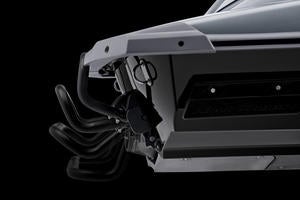 An improved boarding step features a flatter profile that’s easier on feet.
An improved boarding step features a flatter profile that’s easier on feet.Closer inspection reveals additional improvements at the controls. Drivers will likely most appreciate the new “mechanical” neutral feature. The simple addition of a detent in the throw of the reverse lever, it stops the reverse bucket in just the right position to limit most forward or reverse movement, allowing you to start the craft without the typical forward surge. Being able to “shift” into forward or reverse makes for a much better experience around the dock or ramp, although this improvement does come with the typical Yamaha caveat. That lever is still located to starboard, meaning it’s not very easy to use both reverse and throttle at the same time.
Yet another improvement can be seen directly behind the handlebars. The display’s mode buttons, which used to require an awkward reach over the handlebars, are now clustered together in easy reach. Much appreciated, Yamaha.
Strong Power, Better Handling
Though positioned at the lower end of the FX scale, the Cruiser HO isn’t shy on power. Yamaha saw fit to put the 1.8-liter MR-1 engine in this craft, but left off the supercharger. That keeps the price low, avoids the fuel-hungry hit of the forced-air induction, and lowers the intimidation factor a notch. The HO, however, is no slouch. Featuring the industry’s largest-displacement engine, it likely produces around 180 hp and delivers on the water. Top speed peaks in the neighborhood of 63-64 mph, and 0-30 times are just a notch over two seconds.
And for 2012, that power is delivered to the water in better fashion. I’ve always found the FX models to have a slight quirk in the past. They would seemingly fall on and off the hull’s pad while in a turn, which resulted in a quirky, side-to-side wobble. It was never a significant issue, but it’s one that always kept me from truly feeling one with the craft. Now, however, the boat seems to bank sweetly into a turn and display the type of confident manners that had me cranking turns like a street-bike enthusiast on a windy, mountain road. I’m guessing three things produce this effect — the longer hull, new sponson design, and the fact that the keel is now full length.
Same Great Features
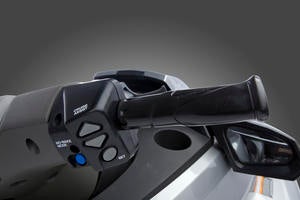 Yamaha’s Cruise Assist feature allows the driver to lock in any speed.
Yamaha’s Cruise Assist feature allows the driver to lock in any speed.As this is an FX, you get all the goodies. Cruise Assist allows the driver to lock in any speed with the push of a button, then allows that driver to simply squeeze the throttle fully to eliminate finger fatigue over long distances, or annoying surges when towing. Release the throttle to deactivate, bump up/down arrows to make minor adjustments. No-wake mode operates in somewhat similar fashion, holding the boat at about 5 mph, but requires no throttle pressure whatsoever. Steering tilts to one of five positions. A manual trim is incorporated into a pivoting section on the left handlegrip. It’s convenient, and doesn’t require you to take your eyes off the water, but may be difficult to operate at peak speed as the force of water exiting the pump works against the mechanism.
Stowage? It measures up at 33.2 gallons, divided between the front storage tub, glovebox, and screw-top canister built into the console. Yamaha’s keyfob-style remote turns the power on, or locks the craft for security. It can also activate a low-speed mode for newbies or to save gas. And yup, that gas is regular 87-octane. No need for pricey premium with a Yamaha.
Oh, and don’t forget the pull-up cleats. You’ll appreciate them at the dock.
Conclusion
A worthy refresh? Absolutely. Yamaha has given the boat new looks and new features that make it a worthy upgrade to its predecessor. The good things about that former model, however, haven’t changed.
In short, I wouldn’t be too surprised if this more economical FX Cruiser started stealing a little more attention in 2012.
| Yamaha FX Cruiser HO Specs | |
| Length | 140.2 inches |
| Beam | 48.4 inches |
| Curb Weight | 825 lbs |
| Engine | Four-cylinder DOHC EFI |
| Displacement | 1,812 cc |
| Bore and Stroke | 86mm x 78mm |
| Compression Ratio | 11.0:1 |
| Rated Horsepower | NA |
| Fuel Capacity | 18.5 gal. |
| Combined Stowage Capacity | 33.2 gal. |
| Colors | Silver Metallic |
| Price | $12,999 |
Related Reading
2012 Yamaha FX Cruiser SHO Review
2011 Yamaha FX HO Review
2011 Yamaha VXS Review
Get PersonalWatercraft.com in your Inbox!
Like PersonalWatercraft.com on Facebook
Comments
Most Popular

2025 Yamaha JetBlaster PRO 2-Up Review

Remembering the Sea-Doo XP

2024 Kawasaki Jet Ski STX 160X Review

Whatever Happened to the Wetbike?

2025 Yamaha JetBlaster Review




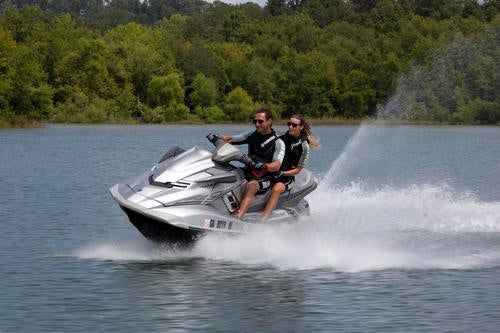
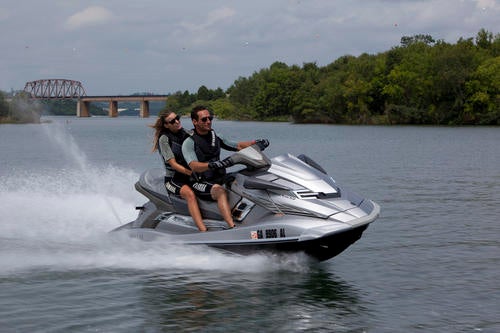
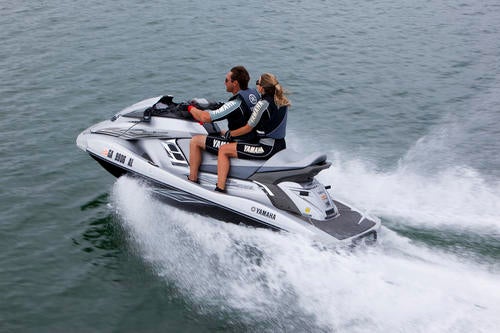







 Your Privacy Choices
Your Privacy Choices